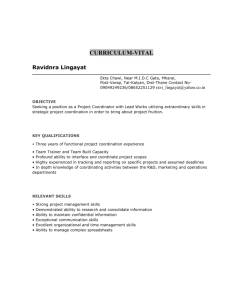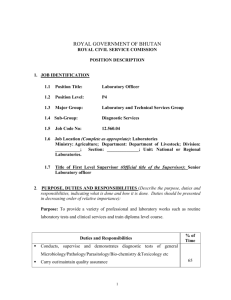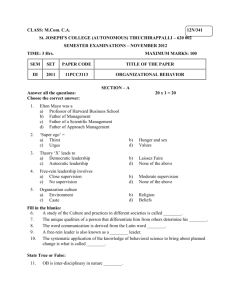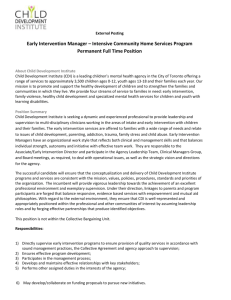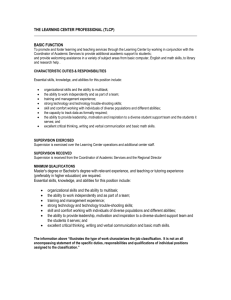Job Description Instructions - Saint Mary's College of California
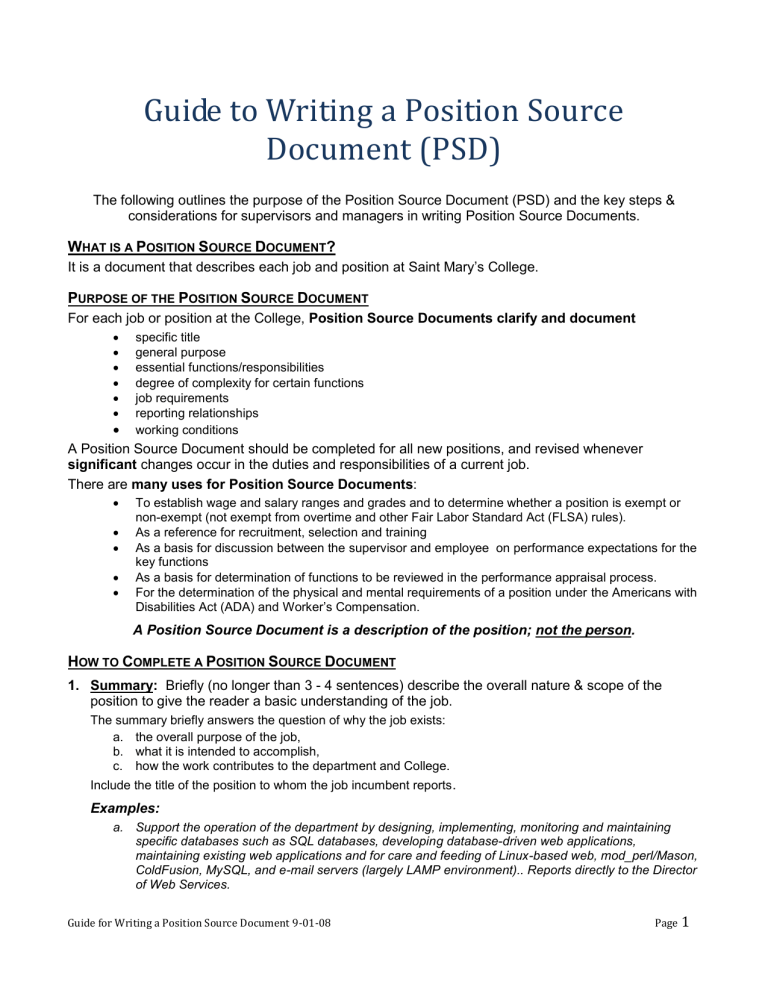
Guide to Writing a Position Source
Document (PSD)
The following outlines the purpose of the Position Source Document (PSD) and the key steps & considerations for supervisors and managers in writing Position Source Documents.
W HAT IS A P OSITION S OURCE D OCUMENT ?
It is a document that describes each job and position at Saint Mary’s College.
P URPOSE OF THE P OSITION S OURCE D OCUMENT
For each job or position at the College, Position Source Documents clarify and document
specific title
general purpose
essential functions/responsibilities
degree of complexity for certain functions
job requirements
reporting relationships
working conditions
A Position Source Document should be completed for all new positions, and revised whenever significant changes occur in the duties and responsibilities of a current job.
There are many uses for Position Source Documents :
To establish wage and salary ranges and grades and to determine whether a position is exempt or non-exempt (not exempt from overtime and other Fair Labor Standard Act (FLSA) rules).
As a reference for recruitment, selection and training
As a basis for discussion between the supervisor and employee on performance expectations for the key functions
As a basis for determination of functions to be reviewed in the performance appraisal process.
For the determination of the physical and mental requirements of a position under the Americans with
Disabilities Act (ADA) and W orker’s Compensation.
A Position Source Document is a description of the position; not the person.
H OW TO C OMPLETE A P OSITION S OURCE D OCUMENT
1. Summary: Briefly (no longer than 3 - 4 sentences) describe the overall nature & scope of the position to give the reader a basic understanding of the job.
The summary briefly answers the question of why the job exists: a. the overall purpose of the job, b. what it is intended to accomplish, c. how the work contributes to the department and College.
Include the title of the position to whom the job incumbent reports .
Examples: a. Support the operation of the department by designing, implementing, monitoring and maintaining specific databases such as SQL databases, developing database-driven web applications, maintaining existing web applications and for care and feeding of Linux-based web, mod_perl/Mason,
ColdFusion, MySQL, and e-mail servers (largely LAMP environment).. Reports directly to the Director of Web Services.
Guide for Writing a Position Source Document 9-01-08 Page
1
b. Reporting to the Accounting Manager, the Accounts Payable Accountant will ensure timely and accurate Accounts Payable/Records Management processing for the flow of invoices and will provide quality customer service in resolving A/P inquiries for both external vendors and internal departments. c. This position reports directly to a College Dean, providing key administrative support to enhance the operational efficiency of the School and its departments and to the accomplishment of the school/department objectives and mission. This position acts as a main internal and external customer service contact for the school and operates within a framework of established policies and procedures.
2. Essential Functions/Responsibilities: a. List in order of importance and/or frequency the 3-6 essential functions of the job that must be performed. b. For each function provide representative components or sub-tasks of the duties/responsibilities to be performed c. Use verbs & explanatory phrases to describe the duty/task/responsibility d. In these examples show, as much as possible, the level & complexity of responsibilities. e. For each essential function state if the function is performed on a daily basis (D), weekly basis (W), monthly basis (M), or yearly basis (Y) over the course of a year. f. For each essential function estimate the percentage of time that the position does this function. The total percentage of time for all essential functions should add up to no more than 100%.
Example:
Event Coordination: Coordinate & juggle a number of events at once; for each event, determine & assess event needs and follow through with minimal supervision; schedule speakers, reserve room, determine and order menu, coordinate room set up, send invitations
In the above example Event Coordination is an essential function/responsibility. Level & complexity of responsibility is addressed by “Coordinate & juggle a number of events at once; for each event, determine & assess event needs and follow through with minimal supervision” Additional tasks include schedule speakers, reserve room, determine and order menu, coordinate room set up, send invitations
Tips:
If the list of essential functions is long, test each responsibility to ensure that: o The position exists explicitly to accomplish this function
A group of common and related tasks are generally grouped together to describe the duties of a broader essential function.
In describing complexity of tasks and degree of individual expertise, consider the following: o Does the position provide administrative support or operational support? What type of support is given? o Does the position involve applying individual expertise in a professional or technical field that requires a degree of independent thought or judgment and to what degree?
3. J OB F ACTORS
Describe the competencies and level required to perform the essential functions of the position.
(The levels for each factor are listed in ascending order.)
A. Problem Solving/Analysis: Describes the amount of problem solving and analysis normally required for completing the typical responsibilities of the job.
1. Check the appropriate descriptor:
Recurring/routine - using pre-defined and documented procedures and instructions
Uncommon variations - uses research and analysis of existing information to identify root causes of problems and to generate alternatives
Guide for Writing a Position Source Document 9-01-08 Page
2
Complex - probes beyond a situation to identify underlying issues
Complex spanning other departments/areas - may use a proactive approach to problem solving and develops preventative measures to ensure problems do not reoccur
Unique with substantial significance - Problem solving and analysis may be at a level that conducts in-depth qualitative and or quantitative analysis that would be the basis of recommendations to new approaches and applications
Strategic & College-wide problems/ issues – Reviews and approves recommended solutions and commits the College to large-scale projects and initiatives with review by the
Cabinet.
2. Give specific examples as evidenced in this particular job
B. Decision Making: Describes the typical level of decision making & the types of decisions this position is required to make on a regular basis.
1. Check the appropriate descriptor:
Limited
Routine
Makes decisions regarding priorities within the immediate work unit
Makes decisions regarding programs (objectives set by management)
Establishes objectives for the overall direction of a department
Makes decisions which result in the initiation of programs that have significant impact on the College’s overall condition.
Makes strategic decisions for College
Tips (In determining the appropriate level, answer the following questions):
Are the decisions routine, basic or complex?
What degree of analysis or research is required to render a decision? o Does the position make decisions on routine issues by using common sense and facts? o Does this position require interpretation of guidelines, policies, procedures and protocols? ( makes decisions regarding priorities) o Does the position make decisions involving putting together straightforward information and selecting the best option from defined alternatives? (routine)
Do they span several departments or areas? Are the decisions unique and have substantial significance? Who will the decisions affect and at what level? o Does this position make decisions which establish objectives for the overall direction of an area of the College?
o Does the position initiate programs that impact the College’s overall condition
(financial, academic, community)?
o Does the position make decisions regarding the strategy & direction of the
College?
2. Give specific examples, as evidenced in this particular job, of the types of decisions that are made on a regular basis.
C. Impact of Decisions: Describes the potential impact that decisions, made on a regular basis, or work results can have on operational effectiveness, creativity and/or customer service.
1. Check the appropriate descriptor:
Limited - impact would generally be confined to the individual’s work & rarely impact the work of others
Moderate - impact would be confined to others in the work group, project or department.
Important - impact would include influencing others directly outside the work area &may affect the quality of internal/external customer service
Guide for Writing a Position Source Document 9-01-08 Page
3
Substantial - impact would often include influencing others within a broad area & having substantial impact on internal/external customer service, procedures & policies.
Significant - impact would significantly influence outcomes such as operational effectiveness, service to internal/external customers, or the attainment of departmental objectives.
Critical - decisions affect the functioning of programs or multiple departmental objectives and would lead to decisions & process improvements that could impact funding or financial measures
Strategic – decisions, planning, recommendations and results have a current and future impact on the success of the College
2. Give specific examples of how the decisions made impact those in the department, outside of the department &/or the College as a whole.
D. Budgetary Responsibility: Describes the degree to which the job is required to develop plans for future expenses & sources of funds and set priorities for allocation of funds.
1. Check the appropriate descriptor:
Not directly involved
Assists in developing or monitoring
Recommends portions of larger budget
Develops & manages budgets for functional area (department)
Develops & manages multiple budgets for department (school)
Develops & manages budgets for College
Tips (To determine the appropriate response answer the following questions):
Does the position assist or monitor the development of budgets/grants by collecting, organizing or analyzing facts and figures?
Does the position have direct input by recommending portions of a larger budget?
Will the individual be responsible for developing and managing a formalized budget for a functional area or multiple area’s and departments?
Does the position manage the College’s budgets and authorize financial agreements or arrangements?
What authority does the position have or to what degree will the job have to commit the
College to financial responsibilities?
2. Give specific examples of budgetary tasks/decisions performed on a regular basis.
Make sure to cite the budget size, number of budget lines, type of budget etc.
E. Communications/Contacts: Describes the purpose of communication, level of verbal or written skills required of the job, as well as the level of interaction with others.
1. Check the appropriate descriptor:
Exchanges job-related information with immediate supervisor or co-workers within
the department - to ensure understanding and provide basic support; requires basic understanding of verbal and written instructions.
Exchanges job-related information with students, staff, faculty or external contact
to provide routine service and support - responds to verbal or written form to routine inquiries; may complete forms and/or prepare straightforward or brief communications or correspondence.
Exchanges job-related information to provide service and support on an ongoing
basis - responds to verbal or written form to non-routine inquires; requires basic writing skills to draft memos, letters or reports.
Communicates to provide service, coordinate information and collaborate with
others - coordinates information exchange & instruction in the day-to-day work
Guide for Writing a Position Source Document 9-01-08 Page
4
environment within the work unit; may work with technical or supervisory staff to prepare formal written communications such as policies, procedures, press releases and/or proposals
Interprets technical information or provides technical or professional advice/guidance to others within or outside the College - may develop &/or conduct group meetings or training sessions & provide information in various formats to educate participants; may prepare complex technical documentation
Persuades, influences or leads others on strategic issues communicates complex information to gain cooperation, problem resolution, or project approval; develops, presents and negotiates contracts, budgets, business plans or grants & proposals.
Negotiates major issues, business plans, contracts and/or partnerships with skill
and diplomacy - plans, develops & communicates the College’s vision, mission and strategies; communicates with executive (Cabinet), alumni, contributors, government officials or the Board of Trustees to build and cultivate relationships.
2. Give specific examples of regular communications & contacts and level(s) of contact.
F. Independence: Describes the amount of guidance or supervision usually present for completing the typical responsibilities of the job.
1. Check the appropriate descriptor for the level of guidance or supervision the position would normally need.
Frequent supervision
Periodic supervision
Minimal supervision
Guided by broad policies, precedents
Guided by in-depth knowledge of College policies & short range plans
Guided by in-depth knowledge of College policies & long range goals – independently commits College to long range projects
2. Give specific examples of levels of independence required in job
G.
Supervision:
1. Check appropriate items which describe the amount and extent of supervisory/planning responsibility, if any, required of the position to achieve the expectations of the job
2. List all positions and full-time equivalency of those this position supervises directly.
Tips:
Supervisor Responsibility refers to those who are responsible for performance reviews, hiring & terminations. They may also establish departmental objectives & delegate assignments or provide strategic direction and develop short & long term goals.
Those who coordinate the work of others but do not directly supervise other staff may train new employees , check the quality of others work , coordinate assignments, provide input into performance reviews , lead task groups, or manage projects. These duties would be described in the section on Essential Functions/Responsibilities
Some positions may be responsible for supervising students. While the level of student supervision varies by department , it is taken into consideration and should be noted.
When describing the type of work done by a student worker, consider o the level of supervision that may be required for those students in leadership positions (Student Life, Campus Activities Board (CAB), visit ambassadors, etc) in comparison with those students in an office environment or another work area o the amount of contact and exposure the student worker has to internal & external constituents.
Guide for Writing a Position Source Document 9-01-08 Page
5
H. Qualifications: Answer the following questions:
1. Is specific education or a degree required for performing the essential functions? If so, what is the degree or education? (Do not place an over emphasis on a specific degree level unless it is truly necessary.)
E.g., Apprentice or journey trade level, Bachelor Degree in appropriate discipline
2. Is “on the job training” or prior experience needed to perform essential functions? If so, what kind of experience and how many years of experience are reasonable to expect?
3. Does the job require basic/advanced or expert knowledge or skills to perform the essential functions of the job? If so what specific knowledge &/or skills are needed?
E.g., basic knowledge or advanced skills of Excel to produce complex charts; excellent written & verbal skills; computer programming skills; strong attention to detail; ability to work independently; knowledge of specific procedures or laws
4. Are there specific licenses or certifications required to perform job?
E.g., CPA, RN, state licensed psychologist, valid CA drivers license, Class C or B
5. Are there any other requirements of the job?
E.g., travel, weekend or evening work, memberships or affiliations in certain job specific organizations
G. Working Conditions - This section is used to define and comply with the Americans with Disabilities Act (ADA) and Workers Compensation programs.
1. Identify the physical and mental abilities required to perform the essential functions and tasks of the position.
2. Specify frequency using the codes (established by Federal and State guidelines)
”C” (constantly) - 6-8 hours per day
“F” (frequently) - 3-6 hours per day
“O” (occasionally) - up to 3 hours per day
“N” (never)
Tips:
Focus on the manner in which the tasks are performed.
Keep in mind that a job function is essential if removal of that function would fundamentally change the job.
E.g., if a job requires filing, it may include bending or squatting; picking up department mail may require lifting and/or carrying up to 25 pounds; placing that mail in a person’s box may include reaching, twisting, and standing.
Use the appropriate code for each item by defining the frequency of the action based on daily basis.
If the work is performed regularly in outdoor situations, there could be extreme exposure to weather variations and conditions. Include these conditions under additional information.
Guide for Writing a Position Source Document 9-01-08 Page
6
